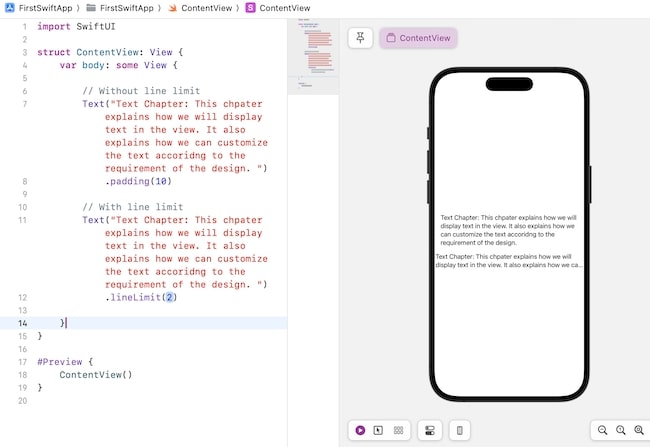
- SwiftUI 教程
- SwiftUI - 首頁
- SwiftUI - 概述
- SwiftUI vs UIKit
- SwiftUI 環境
- SwiftUI - 環境設定
- SwiftUI - 基本元件
- SwiftUI - 構建第一個應用程式
- SwiftUI 檢視
- SwiftUI - 檢視
- SwiftUI - 自定義文字檢視
- SwiftUI - 自定義影像檢視
- SwiftUI - 堆疊
- SwiftUI 繪製形狀
- SwiftUI - 形狀
- SwiftUI - 繪製線條
- SwiftUI - 繪製矩形
- SwiftUI - 繪製圓角矩形
- SwiftUI - 繪製三角形
- SwiftUI - 繪製圓形
- SwiftUI - 繪製星形
- SwiftUI - 繪製多邊形
- SwiftUI - 繪製餅圖
- SwiftUI - 使用內建形狀
- SwiftUI - 文字
- SwiftUI - 文字檢視
- SwiftUI - 文字輸入和輸出
- SwiftUI - 顏色
- SwiftUI - 顏色
- SwiftUI - 顏色選擇器
- SwiftUI - 漸變
- SwiftUI - 調整顏色
- SwiftUI - 效果
- SwiftUI - 效果
- SwiftUI - 混合效果
- SwiftUI - 模糊效果
- SwiftUI - 陰影效果
- SwiftUI - 懸停效果
- SwiftUI - 動畫
- SwiftUI - 動畫
- SwiftUI - 建立動畫
- SwiftUI - 建立顯式動畫
- SwiftUI - 多個動畫
- SwiftUI - 轉場
- SwiftUI - 非對稱轉場
- SwiftUI - 自定義轉場
- SwiftUI - 圖片
- SwiftUI - 圖片
- SwiftUI - 圖片作為背景
- SwiftUI - 旋轉圖片
- SwiftUI - 媒體
- SwiftUI - 檢視佈局
- SwiftUI - 檢視佈局
- SwiftUI - 檢視大小
- SwiftUI - 檢視間距
- SwiftUI - 檢視填充
- SwiftUI - 列表和表格
- SwiftUI - 列表
- SwiftUI - 靜態列表
- SwiftUI - 動態列表
- SwiftUI - 自定義列表
- SwiftUI - 表格
- SwiftUI - 表單
- SwiftUI - 表單
- SwiftUI - 將表單分解成多個部分
- SwiftUI 有用資源
- SwiftUI - 有用資源
- SwiftUI - 討論
SwiftUI - 文字檢視
SwiftUI - 文字檢視
文字檢視在 SwiftUI 中顯示一行或多行靜態文字或字串。它是開發者最常用的構建塊,用於在使用者介面上顯示文字資料。此檢視顯示的文字是隻讀的,這意味著不允許編輯文字。
如果要顯示動態文字,則需要使用帶有變數的文字。我們可以藉助 SwiftUI 提供的預定義修飾符來更改 Text 檢視的外觀和行為。在本章中,我們將學習如何實現文字檢視以及如何自定義文字檢視。
語法
以下是語法:
Text("Hello SwiftUI")
示例
下面的 SwiftUI 程式用於在檢視上顯示靜態文字。
import SwiftUI
struct ContentView: View {
var body: some View {
Text("Hello SwiftUI")
}
}
#Preview {
ContentView()
}
輸出

多行文字
在 SwiftUI 中,我們可以使用文字檢視顯示單行或多行文字或一段落。它還提供諸如 .multilineTextAlignment、lineLimit、.foregroundStyle 等修飾符來自定義使用者介面中多行文字的外觀。
示例
下面的 SwiftUI 程式用於在檢視上顯示多行文字。
import SwiftUI
struct ContentView: View {
var body: some View {
Text("Text Chapter: This chapter explains how we will display text in the view. It also explains how we can customize the text according to the requirement of the design. ").font(.headline)
}
}
#Preview {
ContentView()
}
輸出
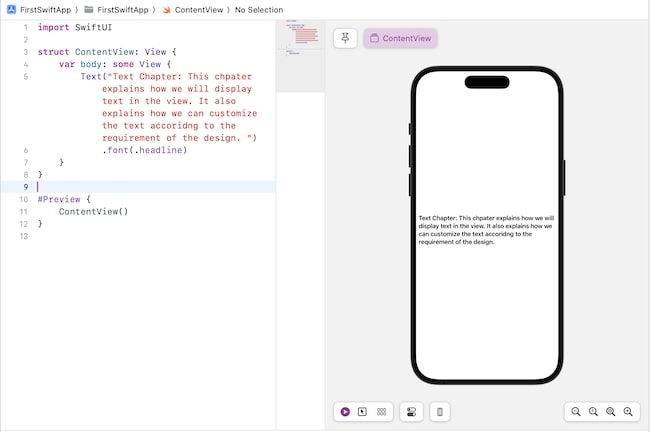
自定義文字檢視
自定義文字檢視意味著我們可以更改文字的外觀,包括文字顏色、背景顏色、字型樣式、對齊方式、行間距等,在使用者介面中。我們可以使用以下修飾符更改文字的外觀以適應介面的所需設計:
- 字型
- 字型樣式
- 對齊方式
- 顏色
- 行間距
- 行限制
讓我們詳細討論這些修飾符以及示例:
自定義字型
我們可以藉助字型修飾符來自定義文字檢視的字型。我們可以透過兩種不同的方式使用此修飾符:
基本字型樣式:此修飾符支援系統已支援的預定義樣式,它們是:.title、.largeTitle、.title2、.title3、.headline、.subheadline、.body、.caption、.caption2 等。以下是語法:
.font(.title)
自定義字型:我們還可以藉助 .font() 修飾符建立自定義字型。在這裡,我們可以指定字型的尺寸、粗細、設計等。以下是語法:
.font(.system(size: 30, weight: .bold))
示例
下面的 SwiftUI 程式用於更改文字檢視中存在的文字的字型。
import SwiftUI
struct ContentView: View {
var body: some View {
Text("Hello SwiftUI").font(.headline)
Text("Hello Swift").font(.system(size: 60, weight: .thin))
}
}
#Preview {
ContentView()
}
輸出
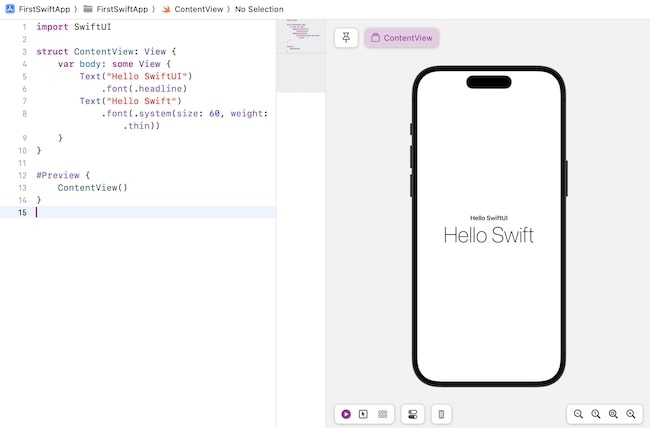
自定義字型樣式
SwiftUI 提供各種修飾符來設定文字檢視中存在的文字的樣式。使用這些修飾符,我們可以調整字型的粗細、設計、大小等。一些常用的字型樣式如下:
| 修飾符名稱 | 語法 | 描述 |
|---|---|---|
| 字型粗細 | .fontWeight()->Text | 此修飾符用於指定給定文字的字型粗細。它只接受一個引數 weight,其值可以是:.black、.bold、.heavy、.light、.medium、.regular、.semibold、.thin、.ultraLight。 |
| 斜體 | .italic() | 用於將斜體應用於文字。 |
| 下劃線 | .underLine()-> Text | 用於為文字新增下劃線。它接受兩個引數:isActive 引數的值表示文字是否有下劃線,而 color 用於表示下劃線的顏色。預設顏色為黑色。 |
| 刪除線 | .strikethrough()-> Text | 用於為文字新增刪除線。它接受兩個引數:isActive 引數的值表示文字是否應用了刪除線,而 color 用於表示刪除線的顏色。預設顏色為黑色。 |
| 字距 | .kerning()-> Text | 用於設定一行中每個字元之間的間距。它只接受一個引數,該引數表示每個字元之間的空間量。此修飾符的預設值為 0。 |
| 粗體 | .bold() | 用於將文字加粗。 |
示例
下面的 SwiftUI 程式用於設定文字檢視中存在的文字的樣式。
import SwiftUI
struct ContentView: View {
var body: some View {
Text("Hello SwiftUI")
.fontWeight(.heavy)
.italic()
.underline(true, color: .green)
.padding(10)
Text("Hello Swift")
.strikethrough()
.kerning(3.0)
.bold()
}
}
#Preview {
ContentView()
}
輸出
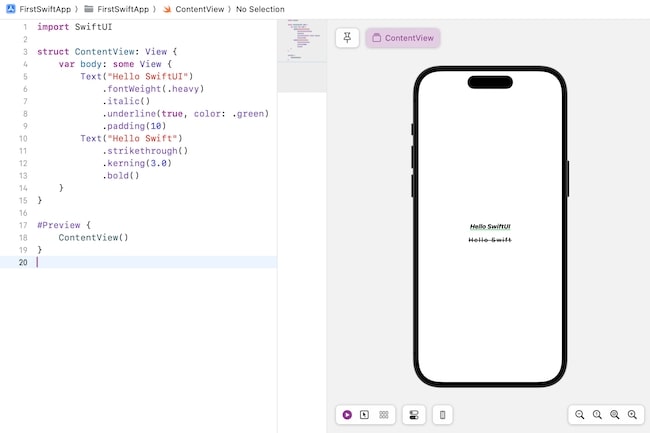
文字對齊
在 SwiftUI 中,對齊用於指定文字在給定容器或檢視內的位置。我們可以使用以下任何修飾符來更改給定文字的對齊方式:
.frame() 修飾符
這用於指定檢視在不可見框架內的位置。以下是語法:
.frame(width:CGFloat, height:CGFloat, alignment: Alignment)
它接受以下引數:
- width:用於設定框架的寬度。如果此引數的值為 nil,則框架的寬度將根據檢視的大小行為進行設定。
- height:用於設定框架的高度。如果此引數的值為 nil,則框架的高度將根據檢視的大小行為進行設定。
- Alignment:用於設定檢視在框架內的對齊方式。此引數的值可以是以下任何一個:.topLeading、.top、.topTrailing、.leading、.center、.trailing、.bottomLeading、.bottom、.bottomTrailing。
multilineTextAlignment(_:) 修飾符
這用於設定文字檢視中多行的對齊方式。以下是語法:
.multilineTextAlignment(_alignment: TextAlignement) -> some View
這隻接受一個引數 alignment。此引數的值可以是以下任何一個:.leading、.trailing 和 .center。
示例
下面的 SwiftUI 程式用於對齊檢視上的文字。
import SwiftUI
struct ContentView: View {
var body: some View {
Text("Hello SwiftUI")
.frame(width: 100, height: 100, alignment: .bottomTrailing)
Text("Text Chapter: This chapter explains how we will display text in the view. It also explains how we can customize the text according to the requirement of the design. ")
.multilineTextAlignment(.trailing)
}
}
#Preview {
ContentView()
}
輸出
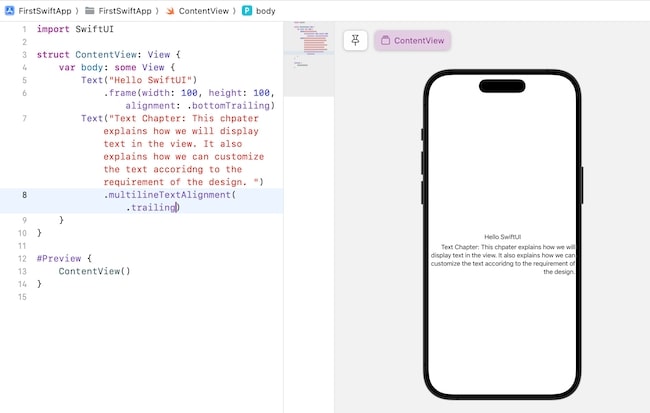
自定義顏色
在 SwiftUI 中,我們可以透過更改文字顏色和背景顏色來增強文字的外觀。我們可以使用以下修飾符來更改文字的顏色:
.foregroundStyle(_:) 修飾符:此修飾符用於設定前景文字/元素的樣式。以下是語法:
.foregroundStyle<S>(_style:S)-> some View where S : ShapeStyle
此修飾符只接受一個引數 style。此處 style 表示前景文字/元素的顏色或圖案。
要更改文字的顏色,我們在此修飾符中使用 Color.colorName 屬性,它會更改文字的顏色。除了 Color 之外,image() 和 linearGradient() 也是 foregroundstyle 修飾符的屬性。
.background(_:) 修飾符:此修飾符用於設定文字檢視的背景顏色。以下是語法:
.background(.colorName)
此修飾符接受我們想要用作文字背景的顏色名稱。
示例
下面的 SwiftUI 程式用於設定檢視上文字的背景色和前景色。
import SwiftUI
struct ContentView: View {
var body: some View {
Text("Hello SwiftUI")
.font(.largeTitle)
.foregroundStyle(Color.red)
.background(.mint)
}
}
#Preview {
ContentView()
}
輸出
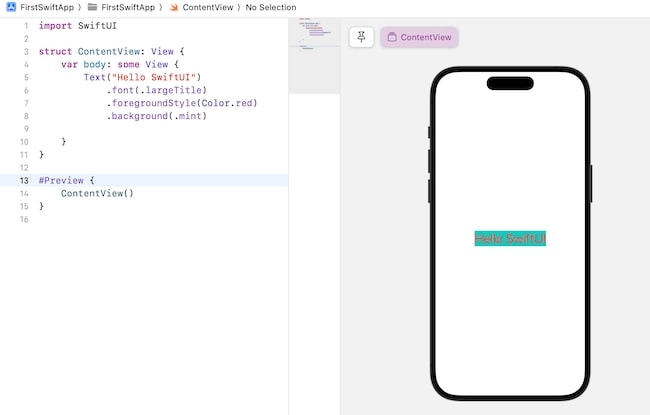
行間距
要在行之間新增額外的空間,SwiftUI 提供了一個 .lineSpacing 修飾符。
語法
以下是語法:
.lineSpacing(_lineSpacing:CGFloat)-> some View
此修飾符只接受一個引數 lineSpacing。它表示一行底部和下一行頂部之間的額外空間量。
示例
下面的 SwiftUI 程式用於在文字檢視中存在的行之間新增行間距。
import SwiftUI
struct ContentView: View {
var body: some View {
// Without line spacing
Text("Text Chapter: This chapter explains how we will display text in the view. It also explains how we can customize the text according to the requirement of the design. ")
.padding(10)
// With line spacing
Text("Text Chapter: This chapter explains how we will display text in the view. It also explains how we can customize the text according to the requirement of the design. ")
.lineSpacing(10.0)
}
}
#Preview {
ContentView()
}
輸出

行限制
為了限制在使用者介面上顯示的行數,SwiftUI 提供了一個名為 .lineLine(_:) 的修飾符。如果給定文字中的文字溢位,則它會在文字的最後一行末尾使用省略號(...)。
語法
以下是語法:
.lineLimit(_number: Int?)->some View
它只接受一個引數,該引數表示行限制的數字。如果此修飾符的值為 nil,則沒有行限制。
示例
下面的 SwiftUI 程式用於限制文字檢視中的行數。
import SwiftUI
struct ContentView: View {
var body: some View {
// Without line limit
Text("Text Chapter: This chapter explains how we will display text in the view. It also explains how we can customize the text according to the requirement of the design. ")
.padding(10)
// With line limit
Text("Text Chapter: This chapter explains how we will display text in the view. It also explains how we can customize the text according to the requirement of the design. ").lineLimit(2)
}
}
#Preview {
ContentView()
}
輸出
